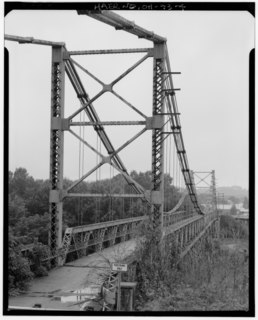
Dresden is a village in Jefferson and Cass townships in Muskingum County, Ohio, United States, along the Muskingum River at the mouth of Wakatomika Creek. It was incorporated on March 9, 1835. The population was 1,529 at the 2010 census.

Zanesville is a city in and the county seat of Muskingum County, Ohio, United States. It is located 52 miles (84 km) east of Columbus. The population was 25,487 as of the 2010 census. Zanesville anchors the Zanesville micropolitan statistical area, and is part of the greater Columbus-Marion-Zanesville combined statistical area.
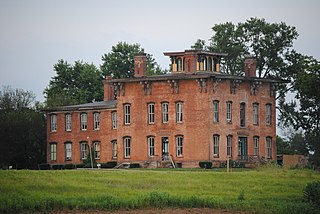
Prospect Place, also known as Trinway Mansion and Prospect Place Mansion, is a 29-room mansion built by abolitionist George Willison Adams in Trinway, Ohio, just north of Dresden in 1856. Today, it is the home of the non-profit G. W. Adams Educational Center, Inc. The mansion is listed on the National Register of Historic Places and the Ohio Underground Railroad Association's list of Underground Railroad sites.
The Pioneer and Historical Society of Muskingum County, also known as the Zanesville Historical Society, is an organization located in Zanesville, Ohio, in the United States, with the mission of preserving the history of the Zanesville and Muskingum County region of Ohio. It is a non-profit entity which operates several important historic sites in and around the Zanesville, Ohio, area, including the Dr. Increase Mathews House, built in 1805 by a founder of the town; and the Stone Academy, erected in 1809 as a possible state capitol, which was also a meeting place for abolitionist societies, and once the home of writer Elizabeth Robins, who wrote about it. The Pioneer and Historical Society of Muskingum County received a Preservation Merit Award from the Ohio Historic Preservation Office Award in 1993 for its work restoring and preserving the Stone Academy.
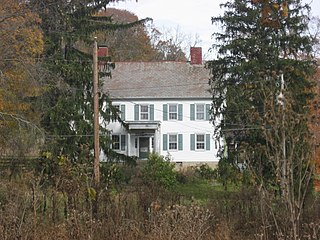
The Adams–Gray House is a historic farmhouse in the community of Adams Mills, Ohio. Constructed in the 1840s in two separate counties, it has been named a historic site.

The Adena Court Apartments are an apartment building in downtown Zanesville, Ohio, United States. Built in 1906, the apartments are a well-preserved example of the Colonial Revival style of architecture of the early twentieth century.
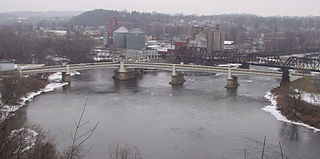
The Zanesville Y-Bridge is a historic Y-shaped three-way bridge that spans the confluence of the Licking and Muskingum Rivers in downtown Zanesville, Ohio. It carries the traffic of U.S. Route 40, as well as Linden Avenue.

H. (Henry) Neill Wilson was an architect with his father James Keys Wilson in Cincinnati, Ohio; on his own in Minneapolis, Minnesota; and for most of his career in Pittsfield, Massachusetts. The buildings he designed include the Rookwood Pottery building in Ohio and several massive summer cottages in Berkshire County, Massachusetts.

The Muskingum County Courthouse is a historic building in Zanesville, Ohio. It was designed by T.B. Townsend and H. E. Myer, and built in 1877 with stone, brick, and slate in the Second Empire architecture style. The building is listed on the National Register of Historic Places and is located at 4th and Main Streets.

T.B. Townsend was a farmer and building company owner. He had one of "the most extensive and well-improved farms in" Marion County, Ohio, at the start of the 20th century, the 2,500-acre (10 km2) Rockland Farm. He was also president of T. B. Townsend Brick and Contracting Co. in Zanesville, Ohio, claimed to be the largest brick factory in Ohio at the time.

The Colonel Joseph Barker House is a historic residence in Washington County, Ohio, United States. Located north of Marietta, in the Muskingum Township community of Devola, it has changed little since its construction in the early nineteenth century, and it has been designated a historic site.
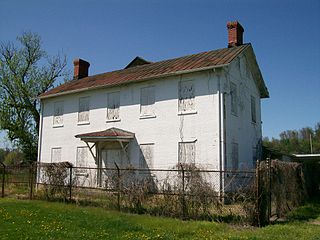
The Judge Joseph Barker House is a historic residence in southern Washington County, Ohio, United States. Located along State Route 7 southwest of the community of Newport, it is a brick structure with a roof of metal, a foundation of sandstone, and other elements of wood and metal. Constructed in 1832, it is a two-story rectangular building that sits atop an Ohio River bluff. Its floor plan is five bays wide, featuring a central entrance with a fanlight and sidelights.
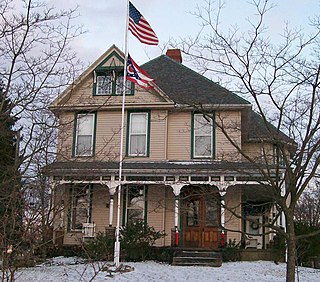
West View is a historic residence in Zanesville, Ohio, United States. Built in 1890, it was one of the first houses to be built in its neighborhood.

The Black-Elliott Block is a historic commercial building in downtown Zanesville, Ohio, United States. Located along Main Street near the Muskingum County Courthouse, it was built in 1876 in the Italianate style of architecture. The partnership of Henry Elliott and Peter Black arranged for the construction of the building; it was one of several significant downtown buildings for which the pair was responsible, along with such important structures as the Clarendon Hotel. At the completion of the building, each man operated his own business inside: of the 31 feet (9.4 m) of building front, Black's store used 16 feet (4.9 m) and Elliott's 15 feet (4.6 m). The building was built of brick on a foundation of sandstone; it also features elements of iron.

The South Fountain Avenue Historic District is a residential neighborhood in Springfield, Ohio, United States. This historic district is listed in the National Register of Historic Places.

Mount Oval is a historic farmhouse in the south central part of the U.S. state of Ohio, south of the city of Circleville. Built in the 1830s, it was home to some of the region's more prominent farmers, and it has been named a historic site.

The Demand-Gest House is a historic residence in the village of Mechanicsburg, Ohio, United States. Built for a physician, it was for many years the home of local business leaders, and it has been named a historic site.

The Rombach Place is a historic house in the city of Wilmington, Ohio, United States. Built in the first third of the nineteenth century, it was home to a family that produced two prominent national politicians. No longer used as a residence, the house is now a museum, and it has been named a historic site.



















